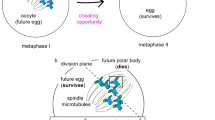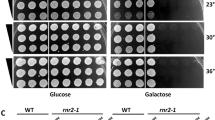Abstract
We find that overexpression in yeast of the yeast MCK1 gene, which encodes a meiosis and centromere regulatory kinase, suppresses the temperature-sensitive phenotype of certain mutations in essential centromere binding protein genes CBF2 and CBF5. Since Mck1p is a known serine/threonine protein kinase, this suppression is postulated to be due to Mck1p-catalyzed in vivo phosphorylation of centromere binding proteins. Evidence in support of this model was provided by the finding that purified Mck1p phosphorylates in vitro the 110 kDa subunit (Cbf2p) of the multimeric centromere binding factor CBF3. This phosphorylation occurs on both serine and threonine residues in Cbf2p.
Similar content being viewed by others
References
Baker RE, Fitzgerald-Hayes M, O'Brien TC (1989) Purification of the yeast centromere binding protein CP1 and a mutational analysis of its binding site. J Biol Chem 264:10843–10850
Baker RE, Masison DC (1990) Isolation of the gene encoding the Saccharomyces cerevisiae centromere-binding protein CP1. Mol Cell Biol 10:2458–2467
Brinkley BR, Valdivia MM, Tousson A, Balezon RD (1989) The kinetochore: structure and molecular organization. In Hyams JS, Brinkley BR (eds) Mitosis: molecules and mechanisms. Academic Press, London, pp 77–118
Cai M, Davis RW (1989) Purification of a yeast centromere binding protein that is able to distinguish single base-pair mutations in its recognition site. Mol Cell Biol 9:2544–2500
Cai M, Davis RW (1990) Yeast centromere binding protein CBF1, of the helix-loop-helix protein family, is required for chromosome stability and methionine prototrophy. Cell 61:437–446
Clarke L (1990) Centromeres of budding and fission yeasts. Trends Genet 6:150–154
Clarke L, Carbon J (1980) Isolation of a yeast centromere and construction of functional small circular minichromosomes. Nature 287:504–509
Cottarel G, Shero JH, Hieter P, Hegemann JH (1989) A 125-base-pair CEN6 fragment is sufficient for complete meiotic and mitotic centromere function in Saccharomyces cerevisiae. Mol Cell Biol 9:3342–3349
Dailey D, Schieven GL, Lim M-Y, Marquardt H, Gilmore T, Thorner J, Martin GS (1990) Novel yeast protein kinase (YPK1 gene product) is a 40-kilodalton phosphotyrosyl protein associated with protein-tyrosine kinase activity. Mol Cell Biol 10:6244–6256
Doheny KF, Sorger PK, Hyman AA, Tugendreich S, Spencer F, Hieter P (1993) Identification of essential components of the S. cerevisiae kinetochore. Cell 73:761–774
Goh P, Kilmartin JV (1993) NDC10: a gene involved in chromosome segregation in Sacchraromyces cerevisiae. J Cell Biol 121:503–512
Hieter P, Pridmore D, Hegemann JH, Thomas M, Davis RW, Philippsen P (1985) Functional selection and analysis of yeast centromeric DNA. Cell 42:913–921
Hyman AA, Mitchison TJ (1991) Two different microtubule-based motor activities with opposite polarities in kinetochores. Nature 351:206–211
Jiang W, Carbon J (1993) Molecular analysis of the budding yeast centromere/kinetochore. Cold Spring Harbor Symp Quant Biol 58:669–676
Jiang W, Philipssen P (1989) Purification of a protein binding to the CDEI subregion of Saccharomyces cerevisiae centromere DNA. Mol Cell Biol 9:5585–5593
Jiang W, Lechner J, Carbon J (1993a) Isolation and characterization of a gene (CBF2) specifying a protein component of the budding yeast kinetochore. J Cell Biol 121:513–519
Jiang W, Middleton K, Yoon H-J, Fouquet C, Carbon J (1993b) An essential yeast protein, Cbf5p, binds in vitro to centromeres and microtubules. Mol Cell Biol 13:4884–4893
Lechner J, Carbon J (1991) A 240 kd multisubunit protein complex, CBF3 is a major component of the budding yeast centromere. Cell 64:717–725
Lim M-Y, Dailey D, Martin GS, Thorner J (1993) Yeast MCK1 protein kinase autophosphorylates at tyrosine and serine but phosphorylates exogenous substrates at serine and threonine. J Biol Chem 268:2115–21164
Mellor J, Jiang W, Funk M, Rathjen J, Barnes CA, Hinz T, Hegemann JH, Philipssen P (1990) CPF1, a yeast protein which functions in centromeres and promoters. EMBO J 9:4017–4026
Neigeborn L, Mitchell A (1991) The yeast MCK1 gene encodes a protein kinase homolog that activates early meiotic gene expression. Genes Dev 5:533–548
Ng R, Carbon J (1987) Mutational and in vitro protein-binding studies on centromere DNA from Saccharomyces cerevisiae. Mol Cell Biol 7:4522–4534
Peterson JB, Ris H (1976) Electron microscopic study of the spindle and chromosome movement in the yeast Saccharomyces cerevisiae. J Cell Sci 22:219–242
Pluta AF, Cooke CA, Earnshaw WC (1990) Structure of the human centromere at metaphase. Trends Biochem Sci 15:181–185
Puziss JW, Hardy TM, Johnson RB, Roach PJ, Hieter P (1994) MDS1, a dosage suppressor of an mck1 mutant, encodes a putative yeast homolog of glycogen synthetase kinase 3. Mol Cell Biol 14:831–839
Sawin KE, Scholey JM (1991) Motor proteins in cell division. Trends Cell Biol 1:122–129
Shero J, Hieter P (1991) A suppressor of a centromere DNA mutation encodes a putative protein kinase (MCK1). Genes Dev 5:549–560
Sikorski RS, Boeke JD (1991) In vitro mutagenesis and plasmid shuffling from cloned gene to mutant yeast. Methods Enzymol 196:302–318
Sikorski RS, Hieter P (1989) A system of shuttle vectors and yeast host strains designed for efficient manipulation of DNA in Saccharomyces cerevisiae. Genetics 122:19–27
Author information
Authors and Affiliations
Additional information
Communicated by C. Hollenberg
Rights and permissions
About this article
Cite this article
Jiang, W., Lim, MY., Yoon, HJ. et al. Overexpression of the yeast MCK1 protein kinase suppresses conditional mutations in centromere-binding protein genes CBF2 and CBF5 . Molec. Gen. Genet. 246, 360–366 (1995). https://doi.org/10.1007/BF00288609
Received:
Accepted:
Issue Date:
DOI: https://doi.org/10.1007/BF00288609




